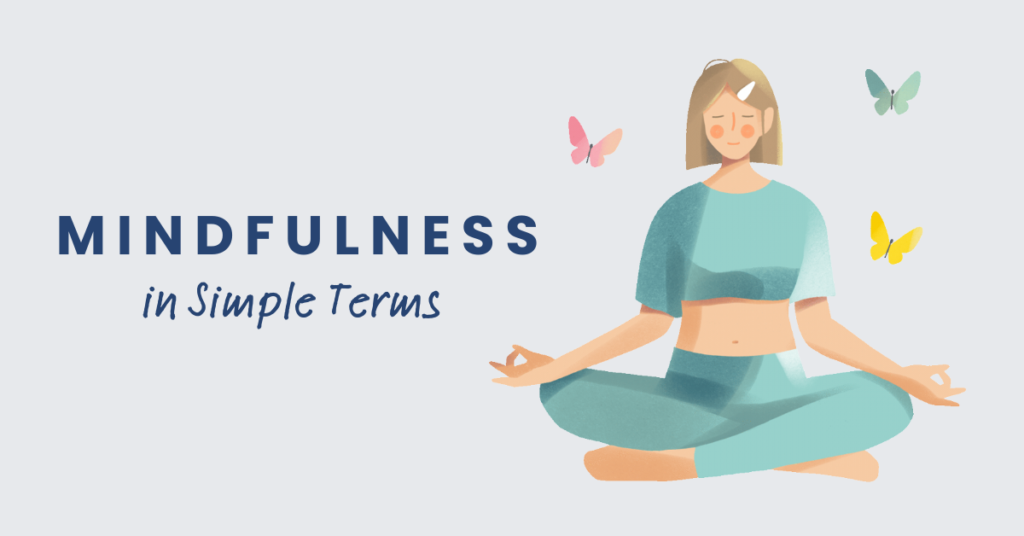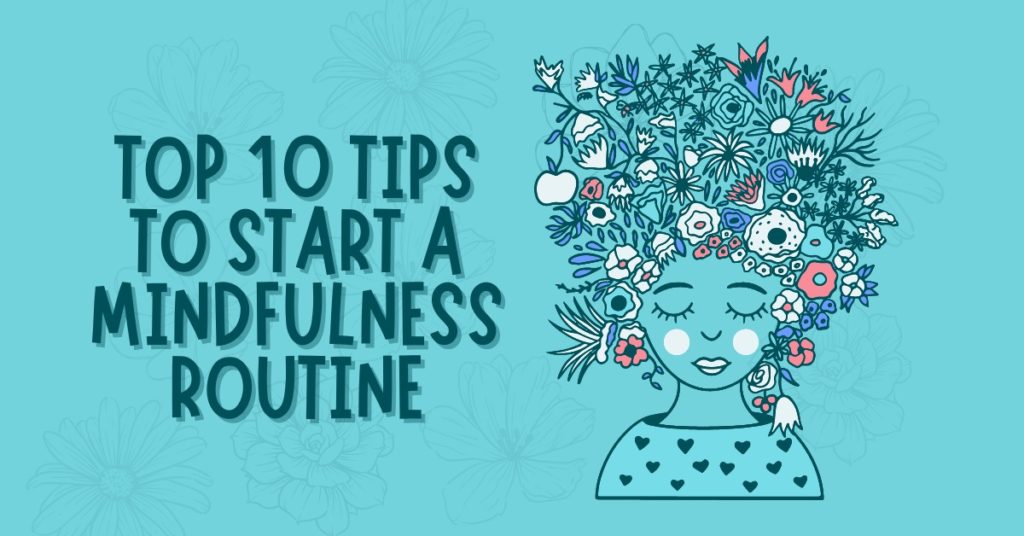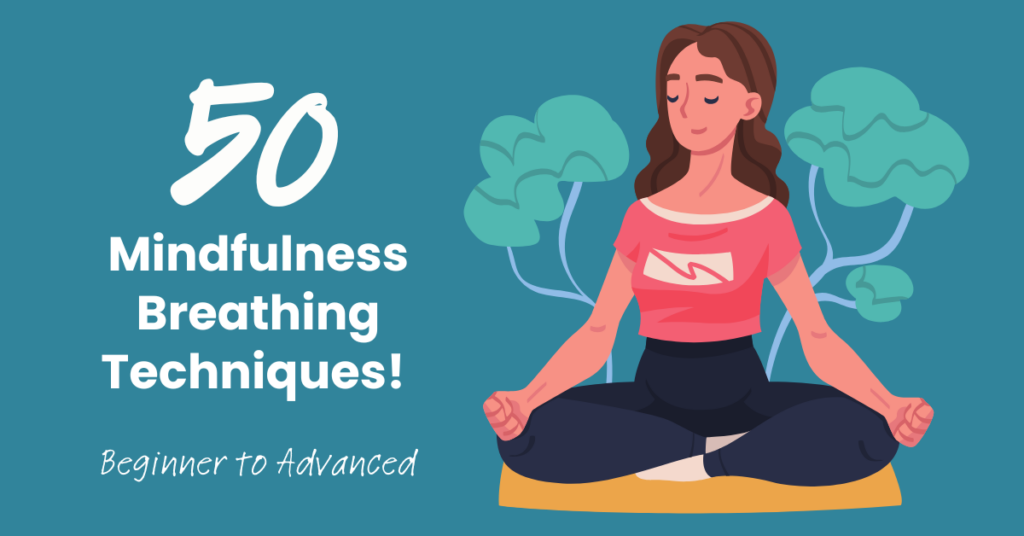Mindfulness is focusing your attention on the present moment in a non-judgmental way. It’s about tuning out distractions (internal and external) and focusing on what you’re experiencing right now rather than being caught up in the past or future.
A few months ago, I was talking to a friend about mindfulness, and she said, “Give me an example.” Our conversation went something like this:
Me: Well, you’re sitting right now. Are you sitting mindfully?
Jessa: What do you mean?
Me: Maddie, are you aware that your feet aren’t flat on the floor? They’re resting on the legs of the chair. (She was sitting on a swivel chair.)
Jessa: Oh!
Me: Are you also aware you’re sitting on the edge of the chair? In the past half hour I’ve been here, I don’t think you’ve ever leaned back to rest against the back of the chair, have you? How does your back feel?
Jessa: Now that you mention it, I do feel my lower back.
Me: So, why do you do it? Why do you sit on the edge of the chair?
Jessa: I don’t know. Habit?
Me: Well, if you practice sitting mindfully, maybe you’ll start to notice these habits and how they affect your body. You might catch yourself sitting uncomfortably or your back or shoulders starting to tense, and then choose to adjust before you feel pain or discomfort.
Jessa: Okay, I think I get what you mean with this “mindfulness” thing.
What’s the Point of Mindfulness?
The primary aim of mindfulness is to cultivate a heightened state of awareness that allows you to observe your thoughts, feelings, and surroundings as they are happening and without judgment. When you do this, you foster acceptance of the present moment, which can help reduce stress, improve focus, and build emotional resilience.
I like to think of mindfulness as a “mental pause.” Often, without realizing it, we find ourselves ruminating about the past or worrying about the future. Our minds are constantly assessing, planning, and calculating, which pulls us away from simply being in the present moment. So, mindfulness is that mental pause you need just to let yourself “BE.” It serves as a tool to reconnect with yourself.
For example, we live in a very rushed world. Life is all about go, go, go! But if you take some time for yourself, mindfulness can help you “step out of the rush” and appreciate the here and now, making it easier to handle life’s challenges with a clearer, more grounded perspective.
Further, mindfulness helps break cycles of automatic thinking and “shoot from the hip” reactions. Ever did or said something you regretted or told yourself, “I shouldn’t have said/done that.” Well, if you’re mindful, you will have fewer of these situations, and you’ll respond to life’s challenges with greater clarity and calm—instead of reacting according to your emotions. When you’re able to take a “mental pause” and give yourself space and time to think, your actions will likely make unpleasant situations better, not worse.

Note: Want to use this infographic? Great! Feel free to download it, but please credit LifeZen by linking back to this article.
How Do You Explain Mindfulness to a Child?
When explaining mindfulness to a child, use simple terms and relatable analogies.
You might say, “Mindfulness is like training your brain to focus, just like how we train our muscles to get stronger. It’s about paying attention to what’s happening right now, like how the wind feels on your skin or how your breath goes in and out.” Engaging children with activities like focusing on their breath or paying attention to the sounds around them for one minute can make the concept more tangible.
How Do You Explain Mindfulness to an Adult?
Mindfulness can be explained as a way to be fully present and aware of one’s thoughts, emotions, and surroundings without being overly reactive or overwhelmed. It’s about noticing what one is experiencing right now, accepting it, and letting it be without trying to change or judge it.
Explain, too, that mindfulness is like a “mental pause” that one needs in stressful or unpleasant situations. It’s giving yourself “time to think” so that you can react more positively (i.e., respond in a way that makes the situation better, not worse.)
Does Mindfulness Work?
Research indicates that mindfulness practices offer numerous benefits, such as reducing anxiety1, depression2,3, and chronic pain4 while enhancing emotional well-being, focus, and overall life satisfaction.
In addition to these benefits, mindfulness practices have been shown to change brain structure and function. A 2011 study at Harvard University found that an eight-week mindfulness program led to increases in gray matter density in brain regions associated with learning, memory, and emotional regulation.5 Participants also exhibited changes in the amygdala, a brain structure involved in stress response, reflecting a reduction in stress reactivity. This research highlights how mindfulness can have a tangible, positive impact on the brain and emotional well-being.
Are There Any Disadvantages to Mindfulness?
While mindfulness offers many benefits, it can also have potential drawbacks for some people in certain circumstances. Engaging in mindfulness practices may trigger difficult emotions or memories, which can be particularly true for those with trauma histories. In this scenario, it might be better to adopt a gradual exposure to mindfulness.
For example, people with trauma histories may benefit from guided mindfulness practices led by trained professionals, such as therapists specializing in trauma-informed care. This ensures a safe space for processing emotions that may surface and that someone is on hand to provide strategies to handle distressing memories.
Additionally, if you start mindfulness with unrealistic expectations of instant relief, you may experience frustration and prematurely conclude that mindfulness doesn’t work for you. So, before you start, it’s important to remember that mindfulness demands patience, consistent effort, and practice, which may not be suitable for individuals seeking quick fixes.
Mindfulness vs. Meditation
Mindfulness is a quality (something you are).
Meditation is a practice (something you do).
Mindfulness is a broader approach that can be practiced at any moment, whether you’re eating, walking, or speaking with someone. It involves actively bringing your attention to your current experience without becoming overwhelmed or lost in it.
Meditation, on the other hand, typically involves setting aside a specific moment to engage in a formal mindfulness practice (such as sitting quietly or focusing on your breath). In essence, you meditate to build and strengthen mindfulness.
How Do I Practice Mindfulness?
Mindfulness practices can range from simple techniques to more structured routines. Here are some examples:
- Mindful Breathing. This is probably the easiest mindfulness practice you can do. Just spend 2-5 minutes paying close attention to your breath. “Tune out” everything as much as possible, and notice your breathing’s natural flow.
- Body Scan. Stressed? A mindful body scan can help release tension. Start by focusing on the top of your head. Notice any sensations or tension without trying to change anything. Next, take a deep breath, and as you exhale, say “release” to yourself. Shift your focus to your forehead. Is it tight or relaxed? Do you notice any furrowing of your brow? If so, inhale deeply, and as you exhale, gently relax your forehead.
Continue down the rest of your body, simply noticing any sensations. Move slowly through your legs to your toes. With each breath, imagine stress being released from your body.
- Mindful Walking. Take a break and go for a walk just because. As you do so, focus on the sensation of your feet touching the ground, the sounds around you, and the feeling of air against your skin. Don’t think of what you did before walking or what awaits you after your walk—just walk.
- Mindful Eating. Pay attention to the flavors, textures, and sensations as you chew and swallow each bite of food. Notice the taste of each ingredient, the way it changes as you chew, and how it feels in your mouth. Observe the act of lifting your fork, the movement of your jaw, and even the sound of your chewing. Take your time with each bite, fully engaging your senses and appreciating the food in front of you. If your mind wanders, gently bring your attention back to the eating experience without judgment. This practice can help deepen your connection with your body, reduce overeating, and enhance your enjoyment of meals.
The key to a mindfulness practice is to be present and aware without reacting or judging. Starting with just a few minutes a day and building up gradually can make mindfulness a more approachable practice.
Characteristics of a Mindful Person
A mindful person typically exhibits qualities such as:
- Present-Centered Awareness. They remain focused on the present moment.
- Non-Judgmental Attitude. They observe their thoughts and emotions without harsh self-criticism.
- Patience and Compassion. They demonstrate empathy toward themselves and others.
- Adaptability. They are open to experiences and can navigate change with ease.
- Heightened Observational Skills. They notice details about themselves, others, and their environment.
- Emotional Regulation. They can manage and respond to their emotions thoughtfully rather than reacting impulsively.
- Curiosity. They maintain a genuine interest and openness to exploring their thoughts, feelings, and the world around them without preconceived judgments.
- Acceptance. They are able to acknowledge situations, thoughts, and feelings as they are without resistance or avoidance.
Mindful Moment: A “Beginner” Example
Still confused about mindfulness? Imagine practicing mindful eating: Take a single bite of food and focus entirely on the texture, taste, and sensation as you chew. Pay attention to the way the food feels on your tongue, its flavor, and the act of swallowing, noticing any thoughts or distractions that arise, and then gently bring your focus back to the eating experience.
Mindful Moment: An “Advanced” Example
You’re having a busy day when you feel stress rising during a tense phone conversation. Instead of reacting impulsively, like raising your voice or hanging up on the person, you say, “I need a moment to think about this; can we pause and continue in a few minutes?”
You “step out” of the situation mentally, and you notice the tension in your shoulders, so you do some quick shoulder and neck rolls to help ease this tension. You notice your fast heartbeat, so you take a few deep breaths, feeling the air enter and leave your body, which helps you regain a sense of calm, clarity, and control. You notice that you’re angry, so you acknowledge it without judgment, recognizing that it’s a natural response but choosing not to let it control your behavior.
Next, you pick up the phone and continue the conversation with a more composed and thoughtful approach, responding instead of reacting and guiding the interaction with clarity and empathy.
How to Become Mindful: 7 Tips
1. Start with Your Breath
Begin your mindfulness practice by focusing on your breath. Take a few minutes each day to close your eyes, sit quietly, and pay attention to the sensation of air moving in and out of your lungs. If your mind wanders, gently bring your attention back to your breath. Note: You don’t need to spend a long time on this. Research shows that just 5 minutes of mindfulness (a.k.a. a micropractice) can bring real benefits.6
2. Create a Mindfulness Routine
Incorporate mindfulness into your daily schedule. This could be a morning meditation, a few minutes of deep breathing during lunch, or a reflective journaling session before bed. Consistency helps build the habit of mindfulness.
3. Do One Thing at a Time
We’re so used to multitasking that focusing on ONE TASK at a time can actually be more challenging! So, try dedicating your full attention to one activity, whether it’s brushing your teeth, walking, or having a conversation, without any distractions.
4. Slow Down
Even while multitasking, do your best to slow down. You don’t need to rush through every task or moment. By slowing down, your mind is not “scattered,” and you can give your full attention to your tasks, making each action more intentional. This allows you to notice details, improve focus, and experience greater satisfaction in even the simplest activities.
5. Be Aware of Your Body
Take a few moments to scan your body from head to toe. Notice areas of tension, discomfort, or relaxation. Practicing body awareness can help ground you in the present and improve your connection with your physical sensations. (Shortcut tip: If you don’t have time for a full body scan, just pick a part that feels tense or “off” and dedicate a few moments to releasing tension in that area.
6. Learn to Say “No”
Set boundaries and say “no” to things that do not align with your priorities or overwhelm you. This creates space to be more present and focused on what truly matters, such as engaging mindfully in tasks, relationships, and self-care.
7. Acknowledge Your Thoughts and Emotions—Without Judgment
Mindfulness doesn’t mean eliminating thoughts or emotions—it means observing them without judgment. When you notice yourself feeling stressed or anxious, acknowledge it (e.g., Okay, this person is really stressing me out right now) and let it pass without clinging or reacting to it. For example, take a deep breath in, and as you exhale, imagine the tension or stressful feeling drifting away like a cloud in the sky. This practice fosters a sense of acceptance and helps reduce those automatic (but unhelpful) reactions.
References
- Hofmann, S. G., Sawyer, A. T., Witt, A. A., & Oh, D. (2010). The effect of mindfulness-based therapy on anxiety and depression: A meta-analytic review. Journal of Consulting and Clinical Psychology, 78(2), 169–183. https://doi.org/10.1037/a0018555 ↩︎
- Fu, Y., Song, Y., Li, Y., Sanchez-Vidana, D. I., Zhang, J. J., Lau, W. K., Tan, D. G., Ngai, S. P., & Lau, B. W.-M. (2024). The effect of mindfulness meditation on depressive symptoms during the COVID-19 pandemic: A systematic review and meta-analysis. Scientific Reports, 14(1). https://doi.org/10.1038/s41598-024-71213-9 ↩︎
- Powell, A. (2023, November 9). Harvard researchers study how mindfulness may change the brain in depressed patients. Harvard Gazette. https://news.harvard.edu/gazette/story/2018/04/harvard-researchers-study-how-mindfulness-may-change-the-brain-in-depressed-patients/ ↩︎
- Wielgosz, J., Kral, T. R. A., Perlman, D. M., Mumford, J. A., Wager, T. D., Lutz, A., & Davidson, R. J. (2022). Neural signatures of pain modulation in short-term and long-term mindfulness training: A randomized active-control trial. American Journal of Psychiatry, 179(10), 758–767. https://doi.org/10.1176/appi.ajp.21020145 ↩︎
- Hölzel, B. K., Carmody, J., Vangel, M., Congleton, C., Yerramsetti, S. M., Gard, T., & Lazar, S. W. (2011). Mindfulness practice leads to increases in regional brain gray matter density. Psychiatry Research: Neuroimaging, 191(1), 36–43. https://doi.org/10.1016/j.pscychresns.2010.08.006 ↩︎
- Pratt, M. (2024, November 9). 5 minutes of mindfulness brings real benefits, according to science. Mindful. https://www.mindful.org/5-minutes-of-mindfulness-brings-real-benefits-according-to-science/ ↩︎




Pingback: What is Radical Acceptance? - LifeZen Publications
Pingback: What is Acceptance and Commitment Therapy (ACT)?
Pingback: How to Find an ACT Therapist
Pingback: The Six Core Processes of Acceptance and Commitment Therapy: A Simple Guide - LifeZen Publications
Pingback: 50 Mindfulness Breathing Techniques (Beginner to Advanced)